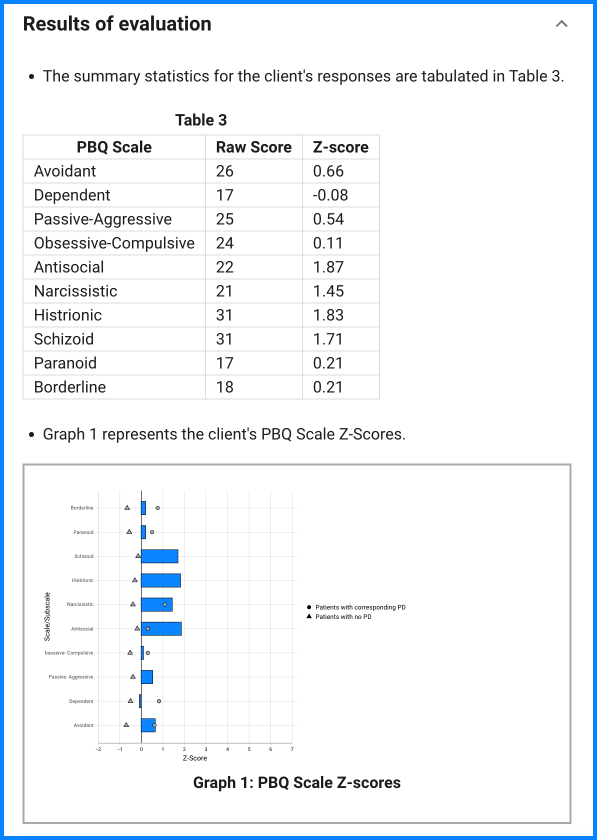There are 10 PBQ scales.
The formula for computing Z scores for each PBQ scale is:
Z score = (patient's raw score - normative mean) / normative SD
Start delivering measurement based mental health care
Conduct psychological assessments remotely, get scores automatically, and maintain clinical records securely
Create account

The Personality Beliefs Questionnaire (PBQ) is a 126-item self-report measure of beliefs associated with personality disorders. Beck and Beck (1991) developed the Personality Belief Questionnaire (PBQ) to measure the beliefs associated with ten DSM personality disorders. The PBQ is a 126-item self report measure of beliefs purported by cognitive theory to be relevant to the following DSM-IV personality disorders: Avoidant, dependent, obsessive-compulsive, histrionic, passive–aggressive, narcissistic, paranoid, schizoid, antisocial and borderline. The items of the PBQ were based on the clinical observation of Beck et al (1990). The PBQ is a promising instrument for identifying beliefs pertinent to a range of personality disorders.
You can create a free account on PsyPack to access fillable PDFs, manuals and educational resources for the PBQ
There are 10 PBQ scales.
The formula for computing Z scores for each PBQ scale is:
Z score = (patient's raw score - normative mean) / normative SD
| PBQ Scale | Raw Score | Z-score |
|---|---|---|
Avoidant | Sum of items 1-14 | (Raw score - 18.8)/10.9 |
Dependent | Sum of items 15-28 | (Raw score – 18.0)/11.8 |
Passive-Aggressive | Sum of items 29-42 | (Raw score – 19.3)/10.5 |
Obsessive-Compulsive | Sum of items 43-56 | (Raw score – 22.7)/11.5 |
Antisocial | Sum of items 57-70 | (Raw score – 9.3)/6.8 |
Narcissistic | Sum of items 71-84 | (Raw score – 10.0)/7.6 |
Histrionic | Sum of items 85-98 | (Raw score – 14.0)/9.3 |
Schizoid | Sum of items 99-112 | (Raw score – 16.3)/8.6 |
Paranoid | Sum of items 113-126 | (Raw score – 14.6)/11.3 |
Borderline | Sum items 4, 9, 13, 15, 16, 18, 27, 60, 97, 113, 116, 119, 125, and 126 | (Raw score – 15.8)/10.5 |
Criterion Group Z-scores
| PBQ Scale | Patients with corresponding PD | Patients with no PD |
|---|---|---|
Avoidant | 0.62 | -0.69 |
Dependent | 0.83 | -0.49 |
Passive-Aggressive | No data | -0.38 |
Obsessive-Compulsive | 0.31 | -0.51 |
Antisocial | 0.31 | -0.18 |
Narcissistic | 1.10 | -0.38 |
Histrionic | No data | -0.29 |
Schizoid | No data | -0.14 |
Paranoid | 0.51 | -0.55 |
Borderline | 0.77 | -0.65 |
PsyPack can automatically score the PBQ assessment and prepare corresponding tables and graphs.

Personality
The purpose of the evaluation is to:
Self-administered
Clinical
Questionnaire
18 years and above
About 20 minutes
Since the questionnaire relies on client self-report, all responses should be verified by the clinician, and a definitive diagnosis is made on clinical grounds taking into account how well the client understood the questionnaire, as well as other relevant information from the client.
Statistically speaking, in a mixed-diagnosis outpatient psychiatric sample, 99% of the time a patient’s Z score will fall between -3 and +3, and the average Z score will be 0. Practically speaking, a Z score near or above the Z score listed for a diagnostic group is likely to be diagnostically suggestive and clinically meaningful. However, please keep in mind the following:
(1) The PBQ assesses beliefs associated with various Axis II disorders. It does not directly assess the criterion behaviors for these disorders.
(2) Assessment of criterion behaviors should be done through other assessment methods (e.g., diagnostic interviewing).
(3) There is no empirically established cut-off score on the PBQ that indicates the presence or absence of a personality disorder diagnosis.
Cognitive theory of personality disorders emphasizes the importance of schemas and core beliefs as organizational structures and global mental representations that guide information processing and behavior (Beck, Freeman, Davis, & Associates, 2003). Research over the past decade has identified specific sets of dysfunctional beliefs that are empirically associated with the various Axis II personality disorders (Beck, Butler, Brown, Dahlsgaard, Newman, & Beck, 2001; Butler, Brown, Beck, & Grisham, 2002). Being cognizant of the prototypic cognitive profile of each personality disorder can help guide clinicians as they conceptualize difficult cases.
Personality disorder beliefs have been measured using the Personality Belief Questionnaire (Beck and Beck, 1991). Beck et al. (2001) recently examined the criterion validity of the PBQ Avoidant, Dependent, Obsessive-Compulsive, Narcissistic, and Paranoid scales among psychiatric outpatients with corresponding SCID-II-derived diagnoses. Findings strongly supported the study predictions. In general, patients with one of these Axis II diagnoses scored higher on the corresponding PBQ scale than patients with alternative Axis II diagnoses. Also, patients scored significantly higher on the PBQ scale theoretically associated with their Axis II diagnosis than on PBQ scales associated with other personality disorders. A subsequent study conducted by Butler et al. (2002) identified 14 PBQ beliefs that empirically distinguish patients with borderline personality disorder from patients with other personality disorders.
The PBQ can be used clinically in two ways: to provide a cognitive profile and to identify specific dysfunctional beliefs that can be addressed in treatment. One benefit of a PBQ profile is that the relative strengths of beliefs across numerous personality disorders can be seen. This is important since personality disorder patients rarely present with a “pure” personality disorder and co-existing features from multiple personality disorders are common (Clark, 1999). PBQ responses can be reviewed with patients to explore several important areas: for example, how certain beliefs are currently impacting their emotions and behavior and how these beliefs may have been learned and maintained, even in the face of significant contradictory data. Patients can also be guided to assess the relative advantages and disadvantages of holding these beliefs and to develop alternative more adaptive beliefs.
Beck, A. T., & Beck, J. S. (1991). The Personality Belief Questionnaire. Bala Cynwyd, PA: The Beck Institute for Cognitive Therapy and Research.